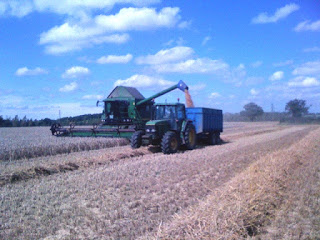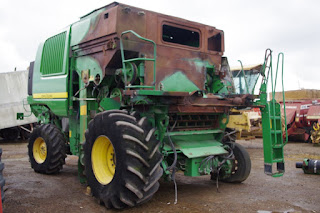Combine Harvester Pre-Harvest Routine
Think of your combine as SpaceX and there's every chance your harvest will be trouble-free. Here we provide an action plan for a smooth lift-off. It's all there from checking to see the lights work to inspecting the threshing mechanism, drum or rotor. |
| Note the plastic spout extension to load trailer at a distance |
Prepare your combine for harvest now
Time spent on the combine before harvest is many times more effective than spending time on the machine once the job has begun. Yet many farmers somehow forget this, doing a minimal oil change grease and check over. They don't want to look for problems that take time and money to put right. It's a costly way to manage this all-important operation.
This article comes from the experience of a number of combine contractors, all who contributed independent ideas - many thanks to all. The aim is to get your combine, whatever age and specification, tuned and ready to go without stopping. Now is the time when you can do the job when things are relatively quiet, away from the pressure of harvest.
Now’s the time to closely inspect the big components. Hair-line cracks in the drum, damage to the rotor, a worn discharge auger can be properly fixed with either farm or outside staff. Better done now than have failure in the middle of harvest.
Oils need servicing early.
Hydraulic oil quality is worth sampling and sending to a lab and changing if advised. If there has been a pump or motor failure it is more likely to be contaminated.Engine oil needs changing now if you didn't do so when you put the machine away. Why? Because oil stood in the sump will separate to sludge at the bottom and deceptively clean oil at the top. The sludge is the first lubricant to circulate, and can block an oilway so a part of the engine runs dry. Disaster. (The author writes from experience).
If you change engine oil in Sept/Oct at the finish of harvest the sludge hasn’t formed. Fill with fresh oil and one job is done. Leaving the sump dry over winter will do seals no good.
Combine electrics are prone to damage. Rats, squirrels and others find grain where there is also some tasty wiring. A pre-harvest checkup should test all the combine functions and problems can be sorted rather than ignored. Vermin will also bite through coolant hoses and these need careful checking as well as testing.
Drive belts and tyres are other parts that can’t be ignored.
Combine shakers and straw walkers vibrate and are liable to break down. They’re not built for life-time use. Cracks can be welded to keep them going, but they need regular inspection to provide a forecast of what is likely to happen. Similarly the cutter bar and header needs close pre-harvest inspection and repair.Essential tools and spares for combine harvesting
Tools and spares are worth sorting out pre-harvest. Having parts that tend to wear out over time, like bearings, chains, belts, sprockets, sickle sections and injector lines reduce downtime as the team is on stop while they are located and collected. Wear on some of these parts can easily be caught by visual inspection.Then there are the tools you need to fit them. Combine contractors can have a full set of belts; a belt-tightener pulley; connector links, half links and chains; sickle sections and guards for the cutterbar; drive chains for the heads; and fingers for the header auger. Engine and hydraulic oil, assorted bearings, bolts and nuts, and welding rods.
Other important, although less obvious, tools that are needed includes the combine service manual and a parts catalog. Also include a ladder to get up the side and a sharp knife to cut wrapped straw.
Fire prevention
Around 80 combines get burnt out in the UK each year. The victims are often modern machines, and this is explained by their high pressure fuel systems - a leak has diesel squirting at high pressure near red hot engines. New combines are as vulnerable as older machines. Fuel tanks are made of plastic; there is a lot of oil on board. The large machines can burn for some time before the driver knows about it - maybe a justification for fitting a camera.
Have a leaf blower in the cab
Modern combines operate in a cloud of dust and chopped straw, which means very regular and effective cleaning. One contributor to Practical Farm Ideas carries a leaf blower in the cab and blows off chaff as many as four to five times a day. Another has fitted a compressor and tank which makes it easy to blow off screens and accumulated chaff.Auto fire extinguisher
Most combines have a standard fire extinguisher, but few have fitted an auto extinguisher like FireTrace which we first described some 20 years ago. The simple idea means the initial flame sets it off and it squirts at the base of the fire. Remember the fire of London started as a small fire in a bakery in Pudding Lane, and Grenfell was an overheating refrigerator.
Prevention through effective cleaning is clearly the best approach. Keeping the machine clean is a vital part of operating it.
Daily maintenance is best done in the morning
Much better to do the daily service and essential inspection in the morning when you’re not dog tired and can do it in daylight. But in the evening, once you have shut down the engine, a five minute tour to check if anything is running hot makes sense.Check engine oil, hydraulic oil, grease the 10 hour ones every day of not more frequently.
Also, inspect and clean screens; open concave door and clean: inspect belts; clean windows.
Winter maintenance checklist
Start with this partial checklist covering the major parts of a combine. You can also check with your service manager for a complete checklist.• Check all lights.
• Tighten all belts as needed.
• Check water pump bearing/tensioner for wear
• Tighten all belts as needed.
• Look for cracks in the belts.
• Check all chains for tightness and wear.
• Check feeder house chains.
• Check elevator chains.
• Check bearings.
• Check the feeder house floor for wear. It may need to be replaced or rebuilt.
• Check the concave for excess wear.
• Inspect the drum bars for straightness and wear.
• Check the conveyor auger bearings for wear and dryness.
• Check fountain and unloading augers for wear.
• Check walkers and bearings for cracks and general wear, or check the rotors. Look for excess wear and check the alignment and bearings.
• Check the total condition of the straw chopper (hammers, knives, shell, rotor). Is the chopper properly balanced or does it shake excessively?
• Weld any and all cracks.
• Check all chains for tightness and wear.
• Check feeder house chains.
• Check elevator chains.
• Check bearings.
• Check the feeder house floor for wear. It may need to be replaced or rebuilt.
• Check the concave for excess wear.
• Inspect the drum bars for straightness and wear.
• Check the conveyor auger bearings for wear and dryness.
• Check fountain and unloading augers for wear.
• Check walkers and bearings for cracks and general wear, or check the rotors. Look for excess wear and check the alignment and bearings.
• Check the total condition of the straw chopper (hammers, knives, shell, rotor). Is the chopper properly balanced or does it shake excessively?
• Weld any and all cracks.
Take advantage of any combine meetings run by your dealer.





